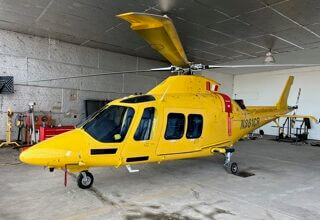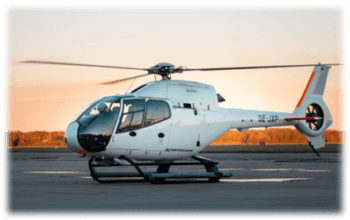Estimated reading time 9 minutes, 58 seconds.
While many of us stay home to curb the spread of COVID-19, frontline workers like those at Ornge, Ontario’s air medical service provider, answer the call each day to ensure essential services still function during the country’s quarantine.

Whether in the cockpit or cabin of an aircraft transporting an infected patient, or back in the maintenance bay disinfecting those aircraft for servicing, the people who help keep our country moving can be exposed to the virus — making stringent precautions a necessity.
That fact isn’t lost on Ornge. Skies chatted with Ornge president and CEO, Dr. Homer Tien, to find out what steps the company is taking to mitigate the risk for its employees.
Some policies were enacted back in January, when the first reported case of the coronavirus surfaced in Canada. Others are still being developed as the company follows ever-shifting guidelines from the Ontario Ministry of Health and other recommendations by Health Canada and the Centers for Disease Control and Prevention (CDC) south of the border.
Regardless, the company is doing what it can to protect its employees — some of which work as intimately with COVID-infected patients as paramedics and doctors on the ground.
Immediate response
As an air ambulance operator, Ornge’s employees have long worked around sick and injured patients, so its flight crews already had access to top-of-the-line personal protective equipment (PPE) even before the pandemic hit. Now, Ornge has made that PPE mandatory for pilots and paramedics operating on flights with confirmed or suspected COVID-19 infected patients.
Knowing they are flying a COVID-infected passenger can cause mental stress for crews. In response to that added weight, Tien said the company is giving pilots and paramedics fair warning of these types of missions, so crews are well aware of the risks involved and how to mitigate them.
“We prepare our crews beforehand for that,” he said. “Then, if they have a COVID transfer or a COVID-suspected transfer, after the flight we give them an operational pause. Time to sort of collect, debrief, talk about any stresses or anxiety that they had around the call, and that’s been very well received as well.”

The company has also begun holding what Tien calls “village town halls” — derived from “town halls” — in which crew members can ask questions and educate themselves about the risk factors involved with flying infected passengers. They’re essentially mini town halls for various Ornge base locations, regions or departments.
“We had one just for aviation staff because they’re probably less familiar with the details of COVID transmission than the paramedics,” he explained. “We wanted to make sure that the aviation staff, in their own setting, had the time to ask questions and have them answered without the paramedics talking about the medical details of COVID particularly.”
In order for Ornge and similar companies to properly prepare pilots and paramedics for an upcoming COVID flight, the provincial database for medical transfers added an extra set of pandemic screening questions for operators to ask hospitals and medical facilities with an outgoing or incoming patient.
“When the first case in Canada was picked up, I think Jan. 25, we turned on our pandemic screening questions and then they’d been modified — the Ministry tells us to change them as more information comes up,” Tien said. “Before it was just ‘did you travel to China?’ But then, as it evolved, it became ‘did you travel outside of Canada?’ The questions changed as the pandemic progressed, but we were able to ask that in real time and then provide warning to our crews and other transport crews to prepare them mentally going in.”
Taking further action
As the pandemic progressed and further news of its spread and impact developed, Ornge instituted restrictions on travel for its flight crews. Any pilots that were training in the U.S. were brought back home and put into a “symptom monitoring regimen” for 14 days, which further developed into complete isolation for two weeks. These pilots weren’t allowed back to work unless completely symptom-free.
The company also put a stop to any inter-base travel for employees, particularly to help further prevent the spread of the virus to the North.
“We’re an essential service particularly to the North because a lot of the communities that we deal with are remote fly-in only communities,” said Tien. “So we didn’t want, particularly, any staff from the South to visit the North because most of the COVID cases in Canada are in the South … so the last thing we wanted to do was introduce it to the North.”

After enacting those measures, and enforcing a work-from-home policy for employees who are able to do so, Ornge looked to re-hire qualified pilots who had left the company for the commercial sector, but been laid off due to the pandemic’s economic fallout.
“We were looking to see of those that were laid off, were any interested in coming back to Ornge, and we were willing to run supernumerary on the presumption that if COVID did come into our ranks, at least we would have more staff available,” Tien articulated.
However, for pilots who had been gone from Ornge for over two years, he said there was a “very comprehensive” onboarding process that “wasn’t worth it.”
“But there were two that I know of that we were able to bring on that were laid off and had left Ornge quite recently, that didn’t require the full onboarding,” he added.
In the air
As for Ornge’s fixed-wing Pilatus PC-12 and Leonardo AW-139 helicopters that would be flying COVID-infected passengers, Tien said that airflow in the rear cabins was an important thing to look at as the virus can be spread through the air.
“We went to the engineers of Pilatus and the AW[139] to look at airflow and to see whether it meets the airflow circulation requirements for caring for infectious disease patients for high risk procedures,” he explained. “There’s certain types of things that we do that are a little more risky than other things.”

For flights with infected patients who are being mechanically ventilated, the risk for flight crews is much lower as the air from those passengers isn’t being randomly circulated into the cabin of the aircraft.
“But if there were small amounts of that being lost around the tube, there’s a certain requirement of air flow exchanges in the cabin of the aircraft per hour that protects the staff that are set by the Centers for Disease Control.
“Say you don’t have that breathing tube in because you’re trying to avoid the mechanical ventilation. You’re blowing in very high flow amounts of oxygen into the nose and it’s spreading through the cabin. If you don’t have good air flow and it isn’t being vented quickly, your cabin crew are at risk for getting the virus,” Tien continued. “So we looked at the engineering design and the air flows in our aircraft and the risk from blowing high flow amounts of oxygen in without them being intubated … And, we can deem that to be too high of a risk of a procedure, even with proper PPE. So there’s certain types of flights that we said we wouldn’t do to protect our crews.”
Tien also added that “we’re not trying to say no to the transports,” so to avoid that possibility, he said crews can change the patient’s mode of ventilation and have them intubated before leaving the sending facility, which “mitigates the spread in the cabin because it’s going into the machine now.”








